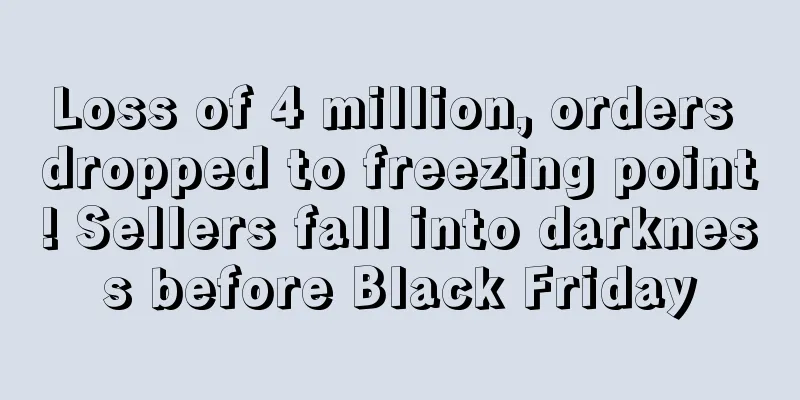Loss of 4 million, orders dropped to freezing point! Sellers fall into darkness before Black Friday

|
It is now late November, the traditional peak season for cross-border e-commerce. As a cross-border seller, have you received a lot of orders?
Black Friday, the first climax of the peak season, is approaching. During the period before Black Friday, many sellers in the industry seem to be experiencing a dark period: orders have been cut in half, and some have even been directly dropped to zero.
However, compared with the previous quarter, the overall traffic during the peak season did pick up, and some sellers took the opportunity to do flash sales to clear their inventory. The low prices during the peak season were chilling. What was even more frightening was that some sellers were unable to handle their squeezed inventory, resulting in a loss of 4 million.
On the one hand, there is a cold winter of orders, and on the other hand, low-price competitors are disrupting the market. Who exactly killed this year's peak season?
In the darkness before Black Friday, sellers' orders dropped to freezing point
In recent days, many Amazon sellers in the industry have reported that their sales have been cut in half, and some have even been cut to the bone, and they just hope not to have zero sales every day.
Black Friday is approaching, and sales have dropped to freezing point during the peak season. Many sellers have not felt the arrival of the peak season at all. Many of them reported that the overall traffic has not declined, and has even rebounded to a certain extent, but the conversion rate is much lower than before.
There are many sellers who have reported a decline in orders recently. More similar situations are as follows:
“——Orders dropped by two-thirds, and people were copying my sales; ——Let me introduce my friends to you: Lin Dan (0 singles); ——Looking at the sporadic visits and orders of the store, I didn’t feel the peak season coming at all; ——0 orders for Christmas products; ——I don’t feel like it’s already November; ——The account balance is often negative; ——The order has been cut off; ——It’s really miserable. The number of orders is small, but the advertising fee is high. ——The number of orders has decreased instead of increased. By comparison, it seems that the first half of the year is the peak season! ”
Compared with the previous months, sellers' sales this month seem to be worse.
One seller said that with the same number of orders as in October, the ranking of the major category was much higher, which shows that the sales of the entire major category has shrunk a lot. It stands to reason that November should be better, but it is not the case at present. An industry insider said that in September, I felt that the peak season was coming; in October, I felt that the peak season was about to end; in November, I felt that the peak season had already gone. This has become a true portrayal of many peers.
While orders have not increased significantly, other costs have increased. An old seller mentioned that the CPC on Amazon has become more expensive recently , and the ACOS is not good either. It feels like everyone is burning money for Black Friday and Cyber Monday. Industry insiders joked that except for the orders, ACOS and CPC have all exploded.
Cross-border people make fun of the current situation: the heavy rain wets my face, and I don’t know whether it is tears or rain; Amazon’s peak season is getting shorter and shorter, just like Guangdong’s winter …
Poor sales have not dampened the will of cross-border traders, and many sellers are pinning their hopes on the upcoming Black Friday promotions.
Some sellers analyzed that the current decline in orders, lower conversion rates, and overwhelming advertising are relatively normal. This is the calm before the peak season and the darkness before Black Friday. Everyone is waiting for the Black Friday promotion to break out.
One seller said that recent orders are almost gone because people are just looking but not buying. Black Friday is coming soon. It feels like Black Friday is the real beginning of the peak season.
Optimistic and positive sellers also told their peers that sellers whose orders are declining should not be anxious, and those who have inventory pressure should not panic, as all the goods should be sold out as soon as Black Friday arrives .
Can Black Friday promotions save sales? What should sellers do before Black Friday? In this regard, veteran sellers in the industry analyzed based on their own experience: Whether Black Friday will explode depends on the specific product attributes. 1. Necessities: Sales will not fluctuate much before and after Black Friday activities; 2. Non-necessities: Sales may fluctuate greatly before and after Black Friday activities.
Sellers of non-essential products who are currently experiencing poor sales can compare their sales with several competing products to analyze whether the overall sales of the category have decreased, or only their own sales have decreased. If the overall sales have decreased, they can use off-site methods to increase sales and seize the time to boost rankings. If only their own sales have decreased, the seller must analyze their own situation to see whether the product has negative reviews, whether the category nodes are correct, whether the advertising keywords are accurate, etc.
Judging from the situation in previous years, during the Black Friday promotion, many sellers will indeed see a surge in orders due to the price advantage, but the surge is only limited to products that previously have a certain foundation . In other words, products that sell well will become even better , and products that sell poorly will find it difficult to soar.
Sellers whose sales volume declined significantly before Black Friday cannot sit back and relax, betting on promotional activities for explosive sales. Entering the peak season in November, the overall traffic volume of e-commerce platforms such as Amazon has not declined, and not all sellers are experiencing a decline in sales volume. Some sellers have achieved growth against the trend, but some sellers have also taken advantage of the increase in traffic to clear out their inventory.
BS took the lead in clearing out stocks and selling off stocks. Some sellers lost 4 million due to overstocking.
This week, while many people were complaining about the drop in orders, some sellers reported the good news of an increase in sales. One seller said, " It's November now, the peak season has really arrived, and orders have started to increase." Another seller said that orders on Monday were not bad.
There is also good news on the European site. A seller said that sales on the European site have started to increase recently, but the gross profit margin has decreased a lot. Because the withholding taxes in Europe were deducted and paid by Amazon, the overall profit directly dropped by nearly 20%.
In terms of specific categories with increased orders, Christmas decoration products and winter products saw more obvious growth, and it is obvious that seasonal products have seen a significant improvement.
On the Meiya search keyword rankings, Christmas decoration products and Christmas trees have already moved up to the first and second positions. Christmas pajamas for family members have also moved up 41 places from 54th last week to 13th.
At the same time, consumers on Amazon are also looking forward to the Black Friday promotions. This week, the keywords for Black Friday sales soared by 428 places.
Search popularity is rising, and the overall traffic on Amazon is also growing. Many sellers took the opportunity to conduct a discount clearance activity. The clearance activities in some categories were very large, and BS took the lead in doing a comminuted fracture promotion. The prices of some categories of products were so low that peers questioned them.
One seller called on his peers to clear out their inventory while traffic was increasing. However, some people were unable to participate in the clearance event. One seller said sadly: "How can I clear out my inventory for Halloween? Maybe I can only wait until next year."
If the inventory cannot be cleared out, the large amount of backlog inventory will have a great impact on the seller. The high peak season warehouse fees plus the high value of the goods will directly cause the seller to face losses. A seller on the Japanese site followed the trend and sold thermal underwear. This type of product has a high value and fierce competition. The seller's products are not selling at all. Currently, there is a lot of backlog of inventory, with a value of up to 4 million. What's more frightening is that the seller's account has a problem and cannot be sold temporarily. All the goods are piled up in the Amazon warehouse. Now, the seller complained to his friends: I lost 4 million this year!
The sellers' overstocking is closely related to logistics delays to a certain extent. One seller said, "My order volume has increased, but I am not happy because the increase is far less than the pressure of inventory. I asked the factory to prepare goods and raw materials in March and April, but the factory only started to prepare when orders were placed in June and July. The factory delivery was delayed, and then the freight became higher and higher, and the delivery time became slower and slower. The goods that should have been sold for about 90 days now have to be sold out within 40-50 days, otherwise there will be a large backlog of inventory."
There may be other reasons that cause sellers to hold back goods. The bitterness behind the sellers who are clearing out inventory can be imagined. If the goods are not unsold, who would clear out the goods in the peak season? Currently, the sellers who are clearing out their goods have reduced their prices to very low levels. These low-priced products have intensified the competition in the industry to a certain extent, affecting the sales of products that were originally sold at normal prices. This may also be one of the reasons why many sellers have seen a decline in orders recently.
The direct cost of clearing inventory at low prices is a sharp drop in profits. Sellers now face triple warehouse rental fees during the peak season + high shipping costs. Even after the price increase, the profit margin is still much lower than before, not to mention sellers who clear inventory at low prices?
The sellers selling at low prices are not all those who are clearing out their inventory, there are also some new competitors. One seller said that he sells in a blue ocean category, and there were not many competitors before, but this year many competitors suddenly entered the market, and they started a low-price spiral competition. The selling price in November this year is similar to that in November last year, but the profit margin has been halved, and the sales volume has been reduced by one third. The low-price spiral is the most hurtful. Now it is the peak season, and Black Friday is coming soon, so he doesn't plan to do the Black Friday activities anymore, and will make a little profit by the end of the year.
Who killed the season this year?
Judging from the current sales situation, this peak season has not reached the popularity expected by sellers. Perhaps buyers are accumulating strength for the Black Friday promotion. Compared with the order volume in October, many sellers said that the order volume has decreased instead of increased. Who is killing this peak season? The factors at the consumer end include reduced consumer confidence, the factors at the platform end include storage capacity restrictions and crackdowns on violations, and the reasons at the seller end include price wars, malicious attacks from peers, and expensive and inefficient logistics.
1. Inflation intensifies and US consumer confidence declines
The consumption capacity of the target market plays a decisive role. Last week, the U.S. Department of Labor released statistics showing that the U.S. Consumer Price Index (CPI) rose 6.2% year-on-year in October, setting a new record since the end of 1990.
Accelerating inflation is driving up commodity prices across the board. Over the past year, the price of eggs in the United States has soared 42%, milk has risen 17%, and bacon has risen 28%. Not only are food prices soaring, but prices of consumer goods such as heating oil, garden furniture, paint, and blinds are also rising. Gasoline prices have soared 60%, and cars have become unaffordable for some families. In addition, prices in service sectors such as catering and medical care are also rising.
After the Labor Department announced that inflation hit a 30-year high in October, the University of Michigan released the preliminary value of the U.S. Consumer Confidence Index for November on November 12. The preliminary value was 66.8, down 6.8% from 71.7 in October and 13.1% from the same period last year, falling to the lowest level in 10 years.
The decline in consumer confidence was affected by rising inflation. A quarter of the consumers surveyed believed that inflation had affected their living standards, with low-income and elderly consumers feeling the most strongly. Although most consumers' nominal income increased, half of the surveyed households believed that their real income would decrease next year after taking inflation into account.
Some analysts believe that consumer spending may remain high after the holiday season. However, compared with the first half of the year, the growth rate of consumer spending in the United States has slowed significantly since the second half of this year. Consumers have begun to notice the increase in inflation, which may further curb consumption. It will take some time for the decline in consumer confidence to really affect spending, said Yong-Yu Ma, an investment strategist at Bloomberg .
What happens when the peak sales season coincides with the lowest consumer confidence in a decade?
2. Storage capacity limitation
This year's storage capacity restrictions have been a tight ring around sellers' heads. Some sellers have bluntly stated that Amazon's storage capacity restrictions killed the peak season in 2021, and orders have been difficult to take off.
Every Monday, many sellers are waiting for the update of the backend replenishment limit data, fearing that it will not come, and even more afraid that it will do something wrong. After each adjustment, some are happy while others are sad. This week, the inventory capacity was updated, and many sellers turned on the irritable mode again, because the inventory capacity was reduced, ranging from 2000 to 5000, and there were constant complaints:
“——Amazon is crazy, it reduced my storage capacity by 5,000 early in the morning; ——I also reduced the price by 2,000 yesterday, and it has been selling quite well recently; ——3,000 storage tanks disappeared overnight; ——Directly reduce by 4,000…”
The good news is that Amazon has increased the inventory capacity of its fulfillment centers in the UK, Germany, France, Spain, Italy, and Canada, giving sellers the opportunity to send more inventory.
For Amazon, when Amazon updated its replenishment restrictions, it informed sellers:
Since the beginning of the epidemic, it has more than doubled the capacity of its U.S. operations centers and hired more than 628,000 employees. Based on these investments, Amazon relaxed replenishment restrictions in October and sellers also delivered record amounts of inventory. Sellers hold an average of 2-3 months of sales inventory in Amazon's operations centers, which can provide sufficient merchandise for promotions.
To ensure that all products are received as quickly as possible, Amazon adjusted the replenishment restrictions on November 14, tightening the replenishment restrictions for standard-size products, clothing, and footwear storage types. Most sellers can still send inventory equivalent to 2-3 months of sales to the operation center. Amazon expects to keep the adjusted replenishment restrictions unchanged during the holiday season and is working to relax the replenishment restrictions as soon as possible. Similar operations have also been taken for self-operated products.
Amazon recommends that sellers can free up more storage space for products within inventory limits by selling inventory, creating removal or disposal orders for products that are unlikely to sell, and canceling non-urgent unshipped items. Replenishment limits are determined by a variety of factors, including the seasonal sales cycle of the product, forecasts for the seller's ASIN and new selections, and the capacity of Amazon's fulfillment centers.
Due to continued storage capacity limitations, some sellers are unable to replenish inventory in large quantities. When orders increase during the peak season, out-of-stock situations are common, and expensive logistics have caused some sellers to simply give up on replenishing inventory.
3. Expensive and slow logistics
Logistics is another major headache for sellers.
Take Matsun Shipping as an example. At the peak of prices in October, Matsun prices once exceeded 30 yuan/kg, which was two times the price last year. Many sellers said they could not afford it. Entering the peak season, air delivery has ushered in a price peak as usual. At the beginning of this month, the price of air freight to the US line has reached 80 or 90 yuan, and even exceeded 90 yuan/kg. A week ago, the price of express delivery to the US line had reached 88 (including fuel), and the price of the European route has also risen to 70 or 80 yuan.
Freight bills have also become a hot potato. With freight costs high, checking bills is a test of sellers' psychological endurance. One seller couldn't help but lament that he owed 70,000 to 80,000 yuan in freight in the middle of the month .
The price of 40+ for air delivery in the first half of the year seems like a dream. Sellers comment on the current air delivery: "The price is sky-high, expensive, slow and unstable." The freight is expensive, but the delivery time has not kept up. On the contrary, the delivery time of channels such as sea, air and rail has hit a new low, and sellers are suffering.
Failure to deliver goods in time means missing out on the peak season. One seller said that six orders have been placed today for a new product that arrived two days ago , but the previous sea freight took more than 50 days, which made him lose a month's profit. Another seller's situation is even worse. The product is about to be out of stock, but the goods are still on the way. It is estimated that a lot of inventory will be left after the peak season. He said, "This peak season is really a disaster for logistics."
The high shipping costs also discouraged a number of users. One seller said that the product was out of stock, but it was still a loss to restock it with air freight of 80+, so he simply gave up restocking.
4. Peer attacks and Amazon’s iron fist
With the arrival of the peak season, there are more reports of sellers encountering malicious attacks from their peers, including malicious negative reviews and trademark extortion.
A seller said that a new product was selling very fast and had received 1-2 bad reviews every day . Currently, bad reviews have a high weight and will be displayed on the homepage quickly once they appear, directly affecting the traffic and conversion of the entire link. A seller's listing received several bad reviews recently, and sales dropped directly.
Some sellers are complaining about their peers through brand preemptive registration. Recently, seller A received an email from peer B, who informed him that seller A’s brand registration was in the lighting category, while most of its sales were clothing and wigs, which were the categories registered by brand B, and Amazon had accepted his complaint. B said that his category registration fee was about 6K, the withdrawal fee was 2K, and the brand bargaining fee was 8K, totaling 18,000, and asked the seller to pay more than 10,000 yuan for settlement.
Another seller, "Amazon Wuye", also encountered trademark extortion. He checked the trademark and found that someone had registered the same name as his on November 9 this year , but in a different category. The routine was similar to that of the seller mentioned above. He reminded other sellers to regularly check whether their trademarks had been registered in other categories.
In addition, Amazon's crackdown on violations has also deterred many sellers, and some stores have been unable to participate in the peak season. An operator said that in the past week, the company's five accounts were blocked one after another , and the previous operation idea of focusing on fake orders was completely abandoned, and began to switch to compliant operations.
Black Friday and Cyber Monday sales may explode in the US
With the current low order volume, some sellers believe that Black Friday is likely to be a flop, while others believe that buyers are accumulating strength and waiting for big sales. However, according to forecast data, this Black Friday and Cyber Monday will not be too bad.
According to eMarketer, during the five-day promotion period from Thanksgiving to Black Friday and Cyber Monday, sales on each promotional day will exceed US$5 billion, an increase of more than 10% over the same period last year. Thanksgiving sales will increase by 20.7% to US$6.1 billion; Black Friday online sales will increase by 15.8% to US$10.42 billion; Cyber Monday online sales will increase by 12.4% to US$12.12 billion, 6.2 times the average daily sales during the holiday period.
Shopify also sent positive signals.
According to Shopify's Black Friday and Cyber Monday consumer forecast survey, 67% of American consumers plan to shop during this year's Black Friday and Cyber Monday, a similar proportion to last year. Compared with last year, the proportion of shoppers planning to shop this year in Italy increased from 84% to 86%, Germany increased from 61% to 65%, and Canada increased from 50% to 61%, and consumers have shown a higher interest. In many countries, including the United States, the amount of money shoppers plan to spend on Black Friday and Cyber Monday this year has increased compared to last year.
The upcoming Black Friday and Cyber Monday are still worth looking forward to. Peak season, hot sales, Black Friday |
<<: Out-of-stock ratio increased by 300%! How to spend Black Friday in the United States
Recommend
What is Warner Overseas Warehouse? Warner Overseas Warehouse Review, Features
Warner Overseas Warehouse is a comprehensive servi...
What is Boy London? Boy London Review, Features
Boy London is a British streetwear brand founded b...
From near bankruptcy to annual sales of tens of millions of dollars, a niche brand successfully turned around
As we all know, professional equipment such as fi...
What is M2E Pro? M2E Pro Review, Features
Founded in 2009, M2E Pro is a large-scale Magento...
Something went wrong with goods worth RMB 200,000. The seller said: I have run the store in vain!
Recently, seller Li Xian revealed that he used a ...
What is Part Finder? Part Finder Review, Features
Part Finder is a new feature in Amazon's imag...
Russian e-commerce company Ozon adds new logistics center to improve delivery capabilities
It is reported that Ozon's new logistics cent...
Sales volume increased by 70%, and electric toothbrushes ushered in a "golden age" during the epidemic
Foreign media reported that due to the impact of ...
Attention! These FBA fees will increase across the board...
What is it like to work for Amazon? Answer: Surpr...
Online traffic in Canada is declining, and sellers are urgently looking to address these issues
Leger research data shows that visits to multiple...
Competition in the Korean e-commerce sector is fierce; Shinsegae acquires 80% of eBay Korea shares
Recently, eBay announced that it has transferred ...
Attention! Amazon European FBA fees will increase...
The Spring Festival holiday has passed. As a cros...
Argentina's online transaction volume in 2020 increased by 124% year-on-year, with a total of 251 million products sold!
In 2020, physical stores encountered "unexpe...
Local sellers hit a record low, but Chinese sellers are still the "leader" of Amazon.com
As the most competitive "battlefield" f...
ONT8 warehouse explosion intensifies! Popular FBA warehouses are difficult to book and build warehouses
Popular FBA warehouses are difficult to book and ...









